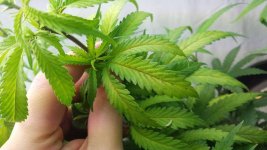FeltchWyzard
Member
Hey magical wonderful people!
I've realized through CrusaderRabbit that I've definitely got something final going on.
Initially it comes on looking like whack pH problems (I now have like 6 probes including a trimeter and guardian). Leaves get yellow, small, deformed, dry tips. eventually they will turn pale and sometimes get pale purple splotching. Stems turn purple and hard then woody. Stalks get real unstable at the bottom by the roots. Roots are tan and easily breakable no bad smell though. Cloning is out of the question. Runoff is dark on the worst plants, amber like a nice beer but not significant ppm, pH rises maybe 0.5-1 from feed in.
Last night I cut down some bad adults and hacked into them to see into the stems and stalks and found some browning inside where the major stems had browning in the core surrounded by dry woody matter. The smaller stems were just dry and woody surrounded by green tight skin. The major stalks mostly had thick brown kinda fuzzy or finery innards (pics below)
Whatever this is either is airborne or comes over from surface over trays and into pots from there. Or possibly by leafs touching.
Does anyone know what kind of fungus this could be? How about some potent fungicides I could use to save the ones just starting to infect(heard of ridomil, is that good?)? Should I clean my room with fungicides? I had been cleaning with physan but now realize my sterile equipment could be reinfected since clearly what I am dealing with is very infectious.
I have been using beneficials like hydroguard,organism xl and ogbiowar but I think they are just slowing the growth. I need to bring out the big guns and fully sterilize and run a couple sterile grows maybe with zone then get back to bennies.




I've realized through CrusaderRabbit that I've definitely got something final going on.
Initially it comes on looking like whack pH problems (I now have like 6 probes including a trimeter and guardian). Leaves get yellow, small, deformed, dry tips. eventually they will turn pale and sometimes get pale purple splotching. Stems turn purple and hard then woody. Stalks get real unstable at the bottom by the roots. Roots are tan and easily breakable no bad smell though. Cloning is out of the question. Runoff is dark on the worst plants, amber like a nice beer but not significant ppm, pH rises maybe 0.5-1 from feed in.
Last night I cut down some bad adults and hacked into them to see into the stems and stalks and found some browning inside where the major stems had browning in the core surrounded by dry woody matter. The smaller stems were just dry and woody surrounded by green tight skin. The major stalks mostly had thick brown kinda fuzzy or finery innards (pics below)
Whatever this is either is airborne or comes over from surface over trays and into pots from there. Or possibly by leafs touching.
Does anyone know what kind of fungus this could be? How about some potent fungicides I could use to save the ones just starting to infect(heard of ridomil, is that good?)? Should I clean my room with fungicides? I had been cleaning with physan but now realize my sterile equipment could be reinfected since clearly what I am dealing with is very infectious.
I have been using beneficials like hydroguard,organism xl and ogbiowar but I think they are just slowing the growth. I need to bring out the big guns and fully sterilize and run a couple sterile grows maybe with zone then get back to bennies.




